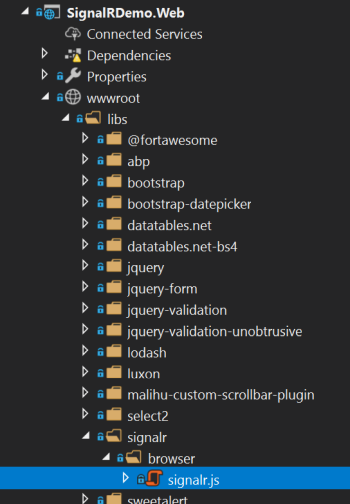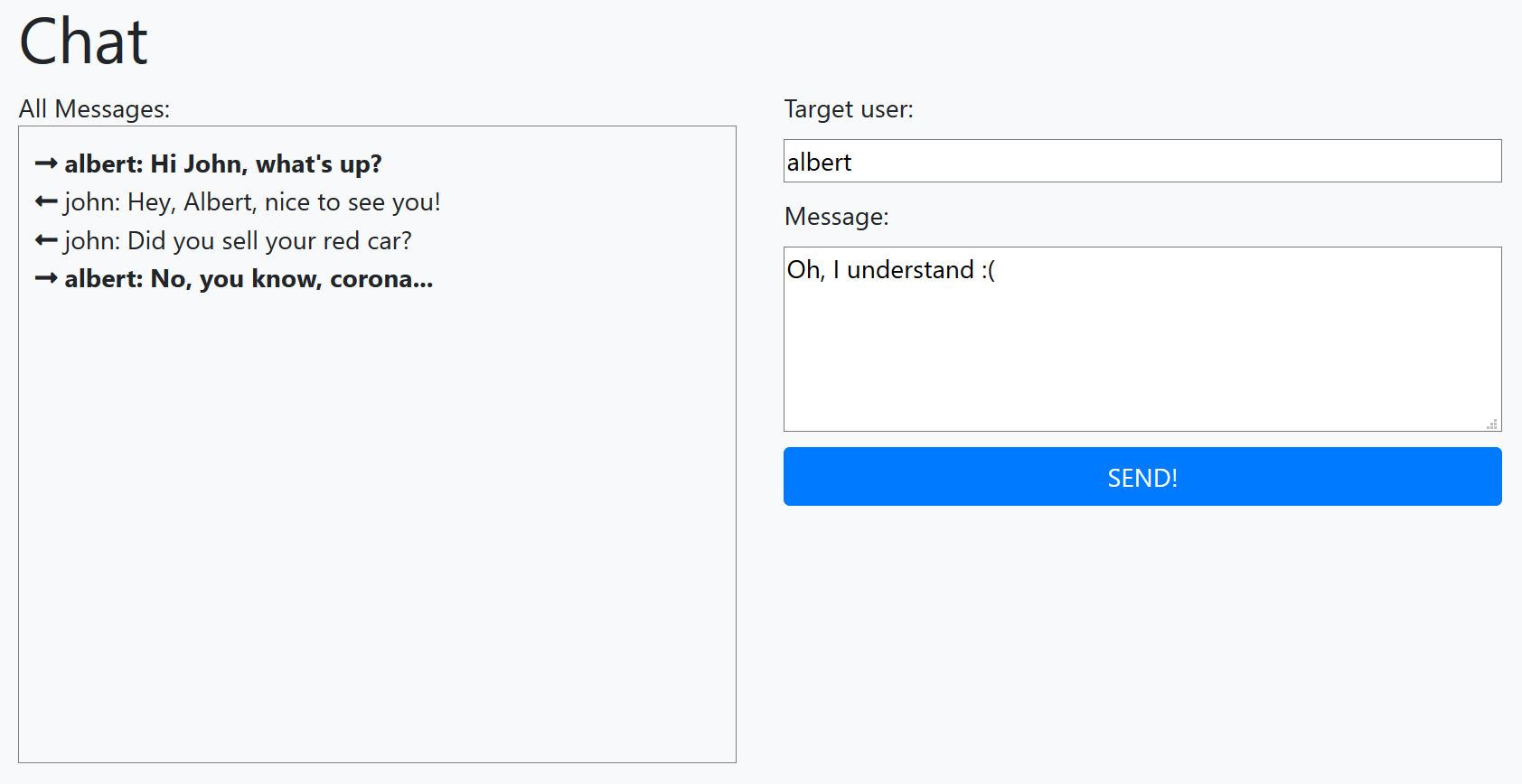8.4 KiB
SignalR Integration
It is already possible to follow the standard Microsoft tutorial to add SignalR to your application. However, ABP provides a SignalR integration packages those simplify the integration and usage.
Installation
Server Side
It is suggested to use the ABP CLI to install this package.
Using the ABP CLI
Open a command line window in the folder of your project (.csproj file) and type the following command:
abp add-package Volo.Abp.AspNetCore.SignalR
You typically want to add this package to the web or API layer of your application, depending on your architecture.
Manual Installation
If you want to manually install;
-
Add the Volo.Abp.AspNetCore.SignalR NuGet package to your project:
Install-Package Volo.Abp.AspNetCore.SignalROr use the Visual Studio NuGet package management UI to install it.
-
Add the
AbpAspNetCoreSignalRModuleto the dependency list of your module:
[DependsOn(
//...other dependencies
typeof(AbpAspNetCoreSignalRModule) //Add the new module dependency
)]
public class YourModule : AbpModule
{
}
You don't need to use the
services.AddSignalR()and theapp.UseEndpoints(...), it's done by theAbpAspNetCoreSignalRModule.
Client Side
Client side installation depends on your UI framework / client type.
ASP.NET Core MVC / Razor Pages UI
Run the following command in the root folder of your web project:
yarn add @abp/signalr
This requires to install yarn if you haven't install before.
This will add the @abp/signalr to the dependencies in the package.json of your project:
{
...
"dependencies": {
...
"@abp/signalr": "~2.7.0"
}
}
Run the gulp in the root folder of your web project:
gulp
This will copy the SignalR JavaScript files into your project:
Finally, add the following code to your page/view to include the signalr.js file
@section scripts {
<abp-script type="typeof(SignalRBrowserScriptContributor)" />
}
It requires to add @using Volo.Abp.AspNetCore.Mvc.UI.Packages.SignalR to your page/view.
You could add the
signalr.jsfile in a standard way. But using theSignalRBrowserScriptContributorhas additional benefits. See the Client Side Package Management and Bundling & Minification documents for details.
That's all. you can use the SignalR JavaScript API in your page.
Other UI Frameworks / Clients
Please refer to Microsoft's documentation for other type of clients.
The ABP Framework Integration
This section covers the additional benefits when you use the ABP Framework integration packages.
Hub Route & Mapping
ABP automatically registers all the hubs to the dependency injection (as transient) and maps the hub endpoint. So, you don't have to use the app.UseEndpoints(...) to map your hubs. Hub route (URL) is determined conventionally based on your hub name.
Example:
public class MessagingHub : Hub
{
//...
}
The hub route will be /signalr-hubs/messaging for the MessagingHub:
- Adding a standard
/signalr-hubs/prefix - Continue with the camel case hub name, without the
Hubsuffix.
If you want to specify the route, you can use the HubRoute attribute:
[HubRoute("/my-messaging-hub")]
public class MessagingHub : Hub
{
//...
}
AbpHub Base Classes
Instead of the standard Hub and Hub<T> classes, you can inherit from the AbpHub or AbpHub<T> which have useful base properties like CurrentUser.
Example:
public class MessagingHub : AbpHub
{
public async Task SendMessage(string targetUserName, string message)
{
var currentUserName = CurrentUser.UserName; //Access to the current user info
var txt = L["MyText"]; //Localization
}
}
While you could inject the same properties into your hub constructor, this way simplifies your hub class.
Manual Registration / Mapping
ABP automatically registers all the hubs to the dependency injection as a transient service. If you want to disable auto dependency injection registration for your hub class, just add a DisableConventionalRegistration attribute. You can still register your hub class to dependency injection in the ConfigureServices method of your module if you like:
context.Services.AddTransient<MessagingHub>();
When you or ABP register the class to the dependency injection, it is automatically mapped to the endpoint route configuration just as described in the previous sections. You can use DisableAutoHubMap attribute if you want to manually map your hub class.
For manual mapping, you have two options:
- Use the
AbpSignalROptionsto add your map configuration (in theConfigureServicesmethod of your module), so ABP still performs the endpoint mapping for your hub:
Configure<AbpSignalROptions>(options =>
{
options.Hubs.Add(
new HubConfig(
typeof(MessagingHub), //Hub type
"/my-messaging/route", //Hub route (URL)
hubOptions =>
{
//Additional options
hubOptions.LongPolling.PollTimeout = TimeSpan.FromSeconds(30);
}
)
);
});
This is a good way to provide additional SignalR options.
If you don't want to disable auto hub map, but still want to perform additional SignalR configuration, use the options.Hubs.AddOrUpdate(...) method:
Configure<AbpSignalROptions>(options =>
{
options.Hubs.AddOrUpdate(
typeof(MessagingHub), //Hub type
config => //Additional configuration
{
config.RoutePattern = "/my-messaging-hub"; //override the default route
config.ConfigureActions.Add(hubOptions =>
{
//Additional options
hubOptions.LongPolling.PollTimeout = TimeSpan.FromSeconds(30);
});
}
);
});
This is the way you can modify the options of a hub class defined in a depended module (where you don't have the source code access).
- Change
app.UseConfiguredEndpointsin theOnApplicationInitializationmethod of your module as shown below (added a lambda method as the parameter).
app.UseConfiguredEndpoints(endpoints =>
{
endpoints.MapHub<MessagingHub>("/my-messaging-hub", options =>
{
options.LongPolling.PollTimeout = TimeSpan.FromSeconds(30);
});
});
UserIdProvider
ABP implements SignalR's IUserIdProvider interface to provide the current user id from the ICurrentUser service of the ABP framework (see the current user service), so it will be integrated to the authentication system of your application. The implementing class is the AbpSignalRUserIdProvider, if you want to change/override it.
Example Application
See the SignalR Integration Demo as a sample application. It has a simple Chat page to send messages between (authenticated) users.
Remarks
ABP Framework doesn't change the SignalR. It works in your ABP Framework based application just like any other ASP.NET Core application.
Refer to the Microsoft's documentation to host and scale your application, integrate to Azure or Redis backplane... etc.

